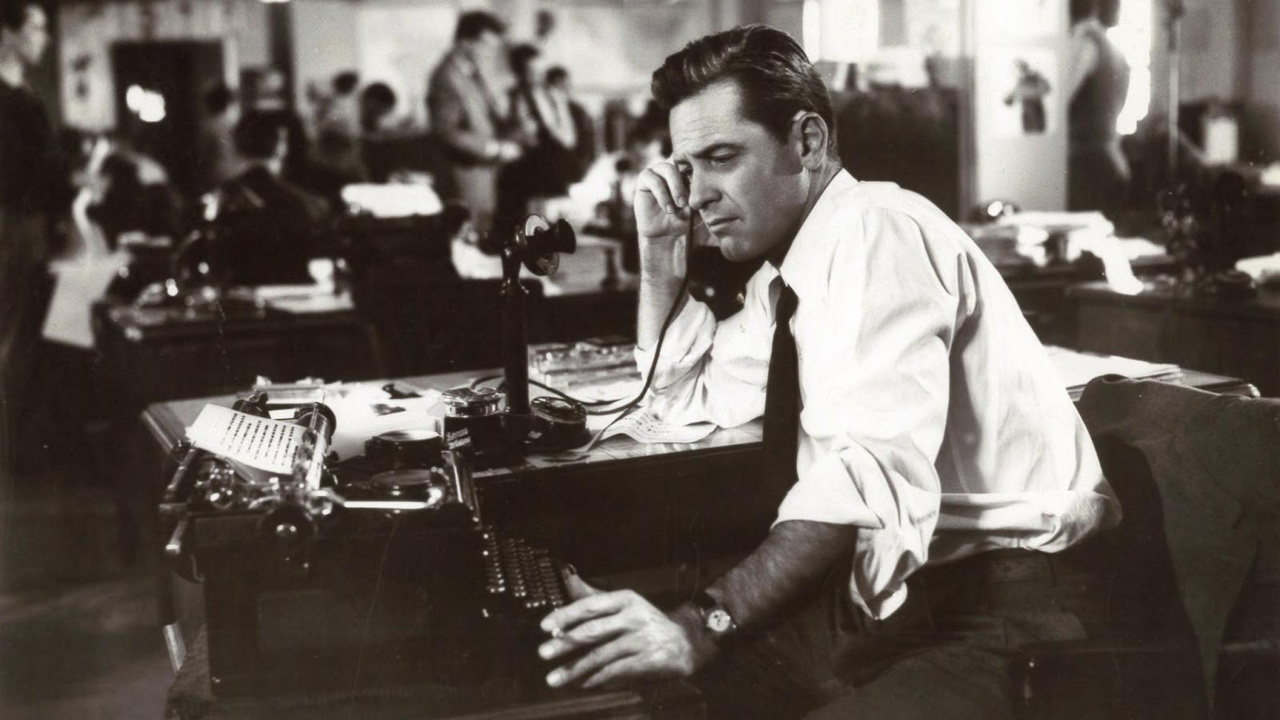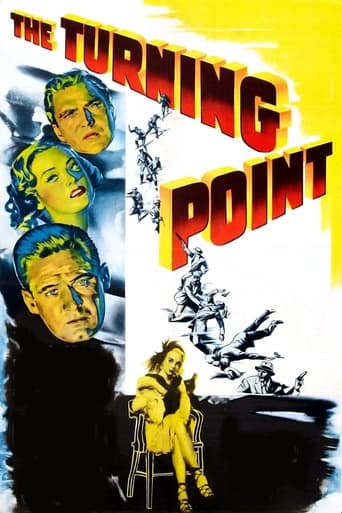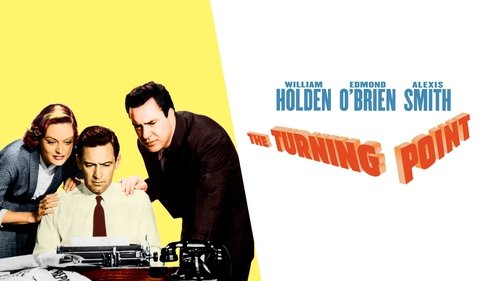


Lack of good storyline.
... View MoreBoring
... View MoreThe story, direction, characters, and writing/dialogue is akin to taking a tranquilizer shot to the neck, but everything else was so well done.
... View MoreIt's a good bad... and worth a popcorn matinée. While it's easy to lament what could have been...
... View MoreThe 85-minutes amounts to a surprisingly good blend of a complexly constructed narrative. The personal, romantic, and political all combine here in what's clearly an effort to tap into Kefauver anti-racketeering hearings of the time. Only here it's Eddie O'Brien as legal eagle Conroy, aided by Holden as hawkshaw reporter McKibbon, both on the trail of racketeering kingpin Ed Begley as Eichelberger. Trouble is Conroy's policeman dad (Tully) has been on the take, so his son must now publicly expose him. Then too, Conroy and buddy McKibbon are in love with same girl, Smith as Amanda. There're a number of threads here, most of which weave in and out effectively.The two biggest pluses are an expert cast, right down to lethally skinny Danny Dayton (Roy) and unforgettable heavy Neville Brand (Red). While dual leads, Holden and O'Brien, low-key their parts effectively. Together, the cast makes the material more plausible than it should be. Second, are the tacky LA locations, from Olympic boxing arena, to skid row, to beloved Angel's Flight tram. The seedy backgrounds also lend a patina of urban realism. Highlights include Red figuring out a catwalk above a fight arena, and the brutal blowing up of Arco's office showing the cruel reality behind Eichelberger's smooth exterior. And catch that surprise ending I didn't see coming.I expect the b&w film was out of step with the Technicolor extravaganzas Hollywood was turning to at the time. The noirish parts especially have a 40's feel to them. Note early clunky appearance of that upstart menace TV, then making inroads into theatre attendance. Too bad this generous slice of professionalism likely got lost in the mix. It may not be one of Holden's better-known films. Nonetheless, the strong points make the 85-minutes worth catching up with.
... View MoreParamount's THE TURNING POINT is unfortunately a forgotten movie. A reasonably good crime thriller the film has suffered probably because of its unavailability in any format. It cannot be found even on VHS and its TV screenings are few and far between. Why this should be is anybody's guess for it is nicely written by Warren Duff and has a sterling cast in William Holden, Edmond O'Brien, Alexis smith and Ed Begley. Produced for the studio in 1952 by Irving Asher it comes from a story "Storm In The City" by Horace McCoy. Crisply photographed in black and white by Lionel Linden it was given a nice noirish style by director William Dieterle. Like Robert Wise's "The Captive City", made the same year, the picture is heavily influenced by the Kefauver Crime Hearings in the U.S. senate in 1950 and 1951 set up to investigate organized crime and its cross border activities.Newly appointed crime commissioner John Conroy (Edmond O'Brien) is determined to crack down on the crooked syndicate that is holding the city to ransom with its extortion racket and other illegal enterprises. With the help of his police detective father Matt Conroy (an excellent Tom Tully) he intends to eliminate the hoodlum element controlled by syndicate boss the ruthless Eichelberger (Ed Begley). But to his surprise he finds his father is reluctant to get involved. Investigative reporter and John Conroy's boyhood friend Jerry McKibbon (William Holden) is suspicious at Matt's reticence in helping out his son and follows him. He is shocked to discover he does business and has dealings with the syndicate. He is now undecided on just how to tell his friend that his father is no more than a crooked cop. To further complicate matters he begins having an affair with John's secretary and girlfriend the attractive Amanda Waycross (Alexis Smith). The picture comes to a nail-biting finish when an out of town hit man (Neville Brand) comes gunning for McKibbon (an exciting sequence at a boxing match) so as to prevent him from reporting anymore about the activities of the mob in his newspaper.The acting is splendid from the entire cast. William Holden in the wake of his brilliant performances in the unforgettable "Sunset Boulevard" and his fine railroad cop in the excellent "Union Station" gives his usual well polished performance this time as a hard bitten newspaper reporter. Excellent too is Edmond O'Brien as the commissioner. O'Brien was an actor who was never known to give a bad performance and doesn't disappoint here. Supplying the romance is the attractive Alexis Smith an actress who for years was buried in nothing roles at Warner Brothers here comes out of her shell to give a nice portrayal of a woman torn between two men. The following year she would steal the acting honours from all around her in RKO's neat little thriller "Split Second".There is no original music in the picture which is something of a disappointment. All that is heard are bits and pieces culled from unused music of Victor Young and Miklos Rozsa and conducted and supervised by Irvin Talbot. However the music score not withstanding the picture doesn't suffer because of it and it remains a good solid crime thriller. Now where is Olive Films to give us the DVD?
... View MoreIt's not easy to make 1952 Los Angeles look very interesting. A panoramic view shows mostly smog. But "The Turning Point" does its best and the location shooting is one of its most admirable features. Prominent use is made of the two-block long funicular railway that runs up from "Pond Street", meaning Hill and Olive Streets in L.A. The incline is lined on both sides with inexpensive clapboard housing that suggests "working class", and some scenes are shot in the doorways and apartments. It's all gone now, railway included, to make way for some bland and pitiless "redevelopment" in 1968. Everything in Los Angeles gives way to redevelopment when the property becomes valuable enough. Stores proudly announce, "Serving The Public Since 2012!" "Chinatown" gave us a picture postcard view of Los Angeles in 1937 and made the place look limitlessly livable.At any rate, cynical reporter William Holden and idealistic anti-crime crusader Edmund O'Brien both grew up in the same neighborhood of Central City or whatever Los Angeles is called here. (So did Ted de Corsia, a thug as usual, but not without principles for a change.) O'Brien is anxious to shut down the crooked gangster who runs the city, Ed Begley. I don't want to give away the entire plot but I guess I can say that Alexis Smith is the girl friend with the striking eyes, especially for a Canadian, who is O'Brien's girl friend but finds herself falling for the hard-bitten reporter. She doesn't have much else to do and is chiefly there to add some romantic drama to the story and to demonstrate that both Holden and O'Brien are heterosexual.Overall, it's rather routine but there are some interesting twists (the corruption reaches into O'Brien's own family) and some nicely done scenes. Aside from the hiding, shooting, and general mishigas on the funicular railway, the scene in which O'Brien rushes to the hospital after his friend Holden has been shot is understated. In a movie that was as corrupt as Central City, we'd expect O'Brien to dash into the hospital's reception room, only to be stopped by a doctor in white. "How -- how is he?", O'Brien would stutter. "I'm afraid we were too late," the doc replies sadly but philosophically. I won't describe how this familiar scene is handled here but it's better than you might think.Another memorable incident is the arrest of Ed Begley, who plays a much more delicate slime ball here than he did in "Twelve Angry Men". He pitches a few sliders here. He's sitting at a table playing cards with his gang under a single light bulb in what looks like a basement. Police sirens wail. The goons knock over their chairs as they run away, but Begley sits still, staring at his cards. A policeman's hand holding a pistol slowly enters the frame from the right. Begley slams down his hand, gets to his feet in a dignified way, looks at the cop, finishes off his drink, and exits towards the police. The scene isn't masterful, but William Dieterle has lifted it out of the ordinary.
... View MoreThe Kefauver crime hearings in the US Senate were the inspiration for several films of which The Turning Point is one. It's neither the best or the worst of that group.Idealistic young attorney Edmond O'Brien is put in charge of a local Kefauver like group with prosecutorial powers to go after the syndicate that operates in this unnamed midwest American city. He's the son of veteran police detective Tom Tully and he asks his father to help him in his investigation. Also helping out are Alexis Smith functioning as the commission secretary and a cynical William Holden who is a long time friend of O'Brien's and newspaper reporter.The syndicate is headed by Ed Begley, his number two is his enforcer Ted DeCorsia and he's got a hotheaded torpedo on the payroll in Danny Dayton. This crime syndicate has its hooks in pretty deep and watching the film you see why they are always one step ahead of the investigating commission. The Turning Point fits right in with Bill Holden's post Sunset Boulevard tough and cynical image. That would reach its apogee when next year Holden would win an Oscar for the ultimate cynic in Stalag 17.The rest of the cast performs well in roles that fit them admirably. Some you will remember are Neville Brand as an out of town torpedo who has few words, but an aura of menace, Carolyn Jones in her film debut as a Virginia Hill type witness who performs on stand the way Judy Holliday did in the House Un-American Activities Committee as the dumb moll. But the performance that really stands out is that of Adele Longmire who is the wife of another torpedo who was doublecrossed and killed after a hit he performed. She is really a standout in her scenes as a frightened witness trying to flee the mob.The Turning Point is a good noir drama that holds up very well today and is even relevant with some of the big name prosecutions of more recent vintage.
... View More